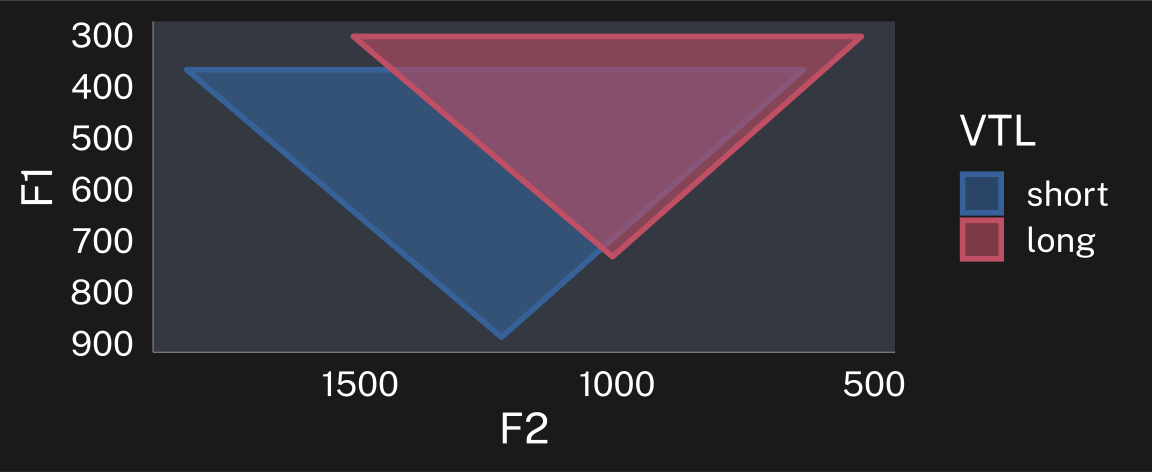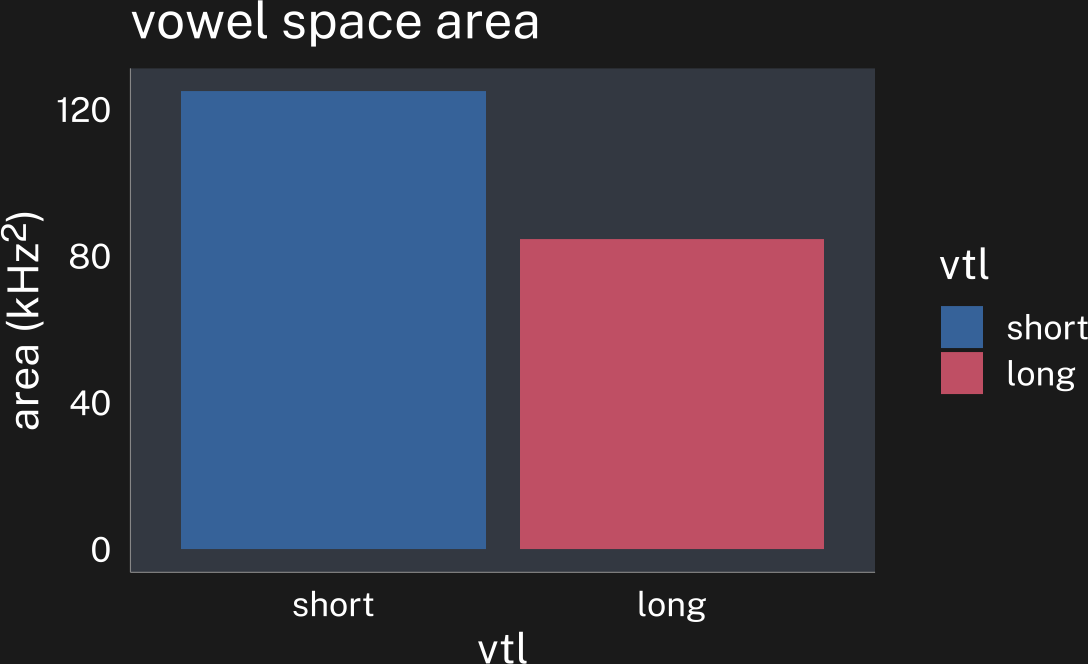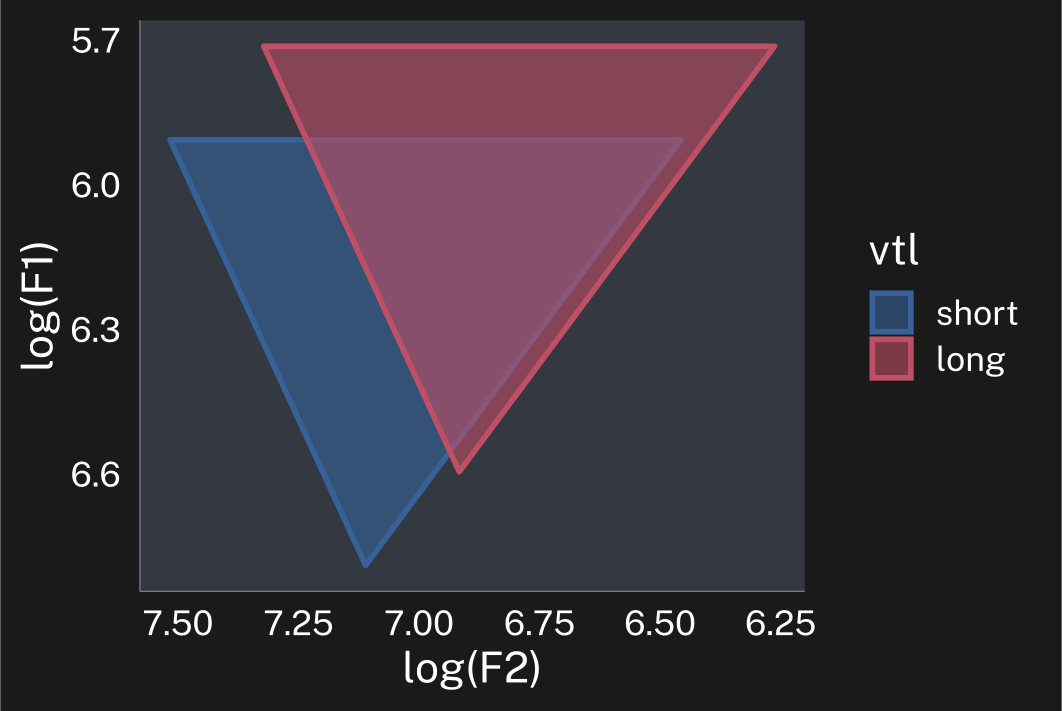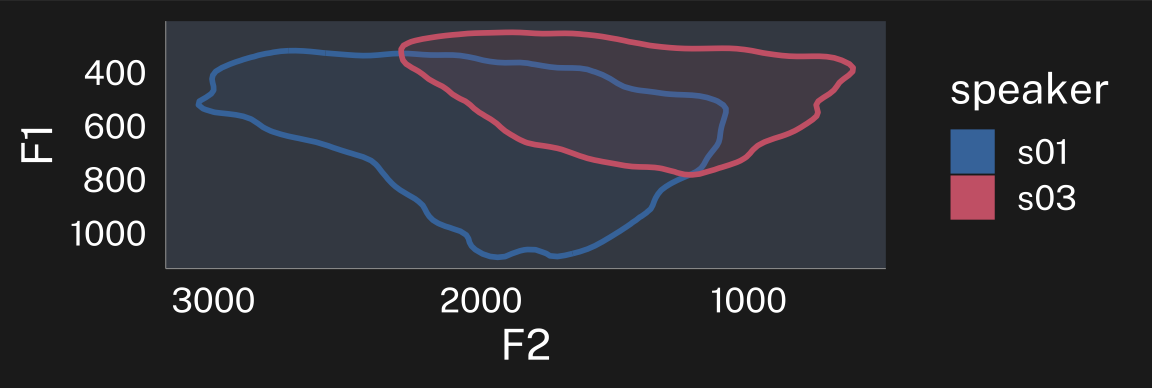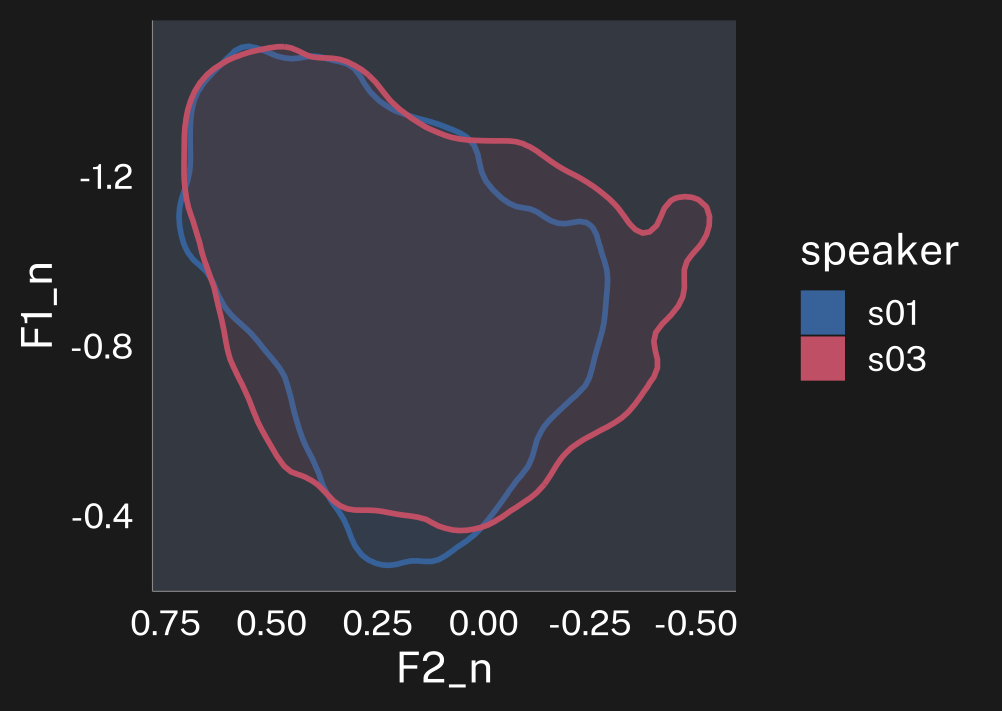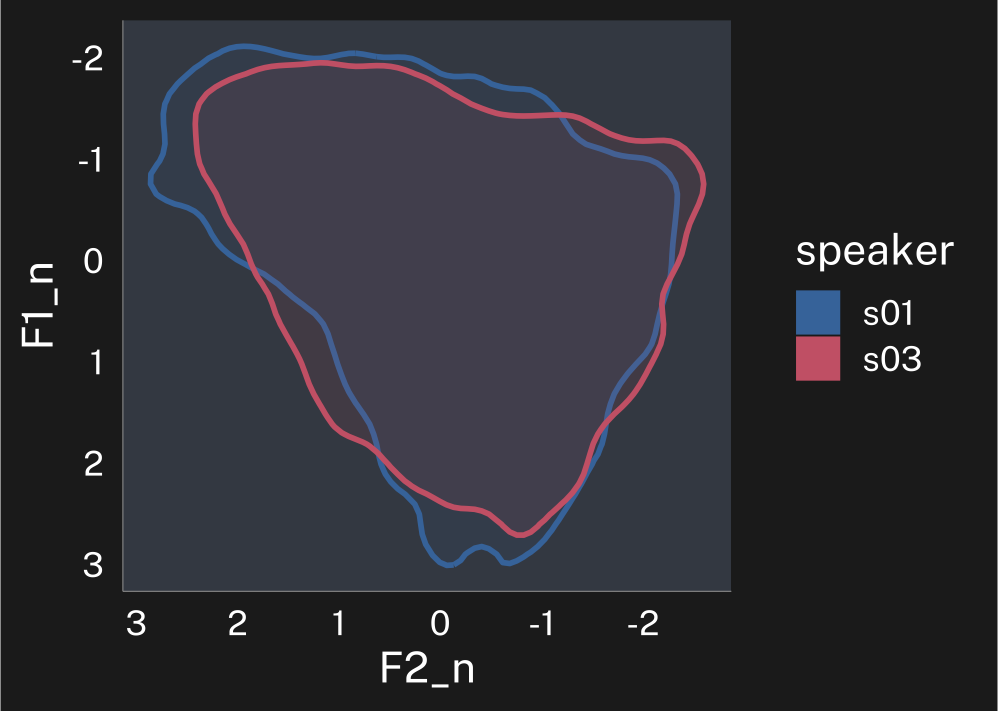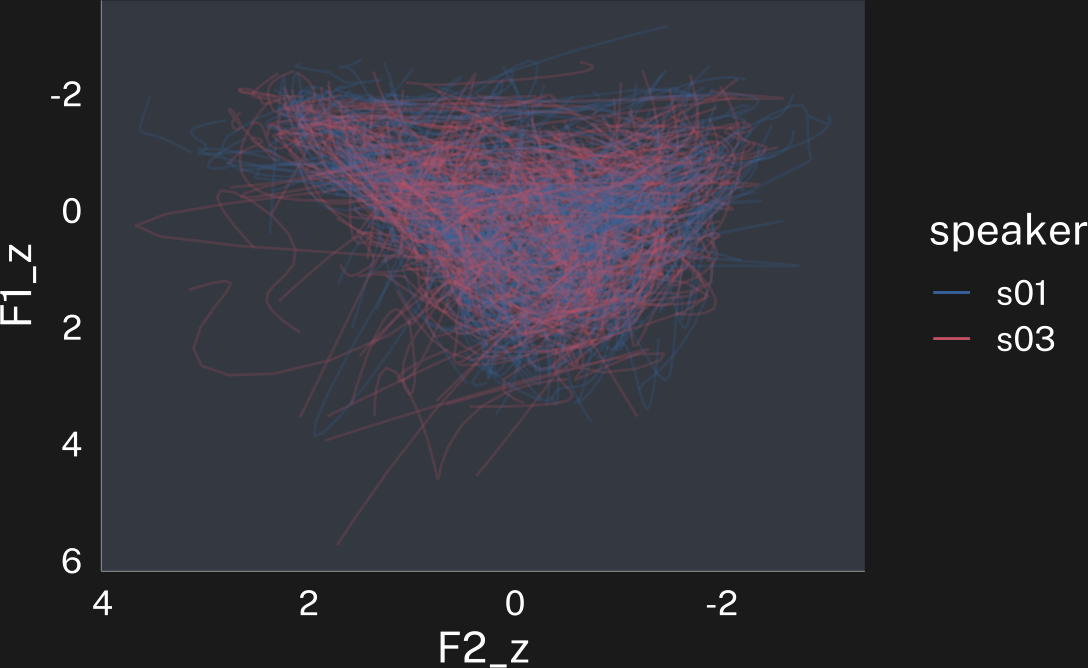The tidynorm package has convenience functions for normalizing
Point measurements
Formant Tracks
As well as generic functions to implement your own normalization method.
You can install tidynorm in your preferred way from CRAN.
install.packages("tidynorm")What is speaker vowel normalization?
Imagine a very tall person from London speaking to you. You can probably imagine what their accent sounds like. Now imagine a very short person speaking to you in the same accent. In reality, if you heard these two people speaking in what you perceive to be identical accents, the acoustics of their speech will be different due to their (likely) different vocal tract lengths (VTL).
Using some rough heuristics and assumptions, the overall vowel spaces of these two speakers might look something like this:
vowel-space-plot
tibble(
vtl = seq(14, 17, length = 2)
) |>
mutate(
F1 = vtl_2_formant(vtl, 1),
F2 = vtl_2_formant(vtl, 2),
F3 = vtl_2_formant(vtl, 3)
) |> mutate(
vtl = factor(vtl, labels = c("short", "long"))
) ->
speaker_formants
speaker_formants |>
reframe(
.by = vtl,
vowel_polygon(F1, F2)
) |>
ggplot(
aes(F2, F1)
) +
geom_polygon(
aes(group = vtl, fill = vtl, color = vtl),
linewidth = 1,
alpha = 0.6
) +
scale_y_reverse() +
scale_x_reverse() +
labs(fill = "VTL", color = "VTL") +
coord_fixed() -> p
p
p+theme_dark()These speakers’ overall vowel spaces have different center points, and cover different areas.
plotting code
speaker_formants |>
ggplot(
aes(F2, F1)
) +
geom_point(
aes(color = vtl),
size = 5
) +
scale_y_reverse() +
scale_x_reverse() +
labs(title = "vowel space center") -> center_p
speaker_formants |>
reframe(
.by = vtl,
vowel_polygon(F1, F2)
) |>
summarise(
.by = vtl,
b = diff(range(F1)),
h = diff(range(F2))
) |>
mutate(
a = (b/100 * h/100)*2
) |>
ggplot(
aes(
vtl, a
)
)+
geom_col(aes(fill = vtl)) +
labs(
y = "area (kHz<sup>2</sup>)",
title = "vowel space area"
)+
theme(
axis.title.y = element_markdown()
) ->
area_plotThe goal of any speaker vowel normalization method is to try to line up speakers’ vowel spaces so that speaker A’s highest, frontest vowels are lined up with speaker B’s, so that speaker A’s lowest, backest vowels are lined up with speaker B’s, etc. Once we have their vowel spaces aligned in a such way that we know similarities between them are matched, we can start investigating any differences.
One really important thing to keep in mind is that vowel space differences due to different vocal tract lengths are not the same as differences in speakers’ pitch. Differences in speakers’ pitch are caused by differences in how their vocal folds vibrate. You can have two speakers’ with the same exact pitch, but very different vocal tract lengths (& vowel spaces), and vice versa.
Normalization methods
All normalization methods involve some kind of shift in the location of a speaker’s vowel space by some value \(L\), scaling the size of a speaker’s vowel space by some value \(S\), or both.
\[ F' = \frac{F-L}{S} \]
They way normalization methods mainly differ is in terms of
Transformations applied to the original formant values before calculating \(L\) and \(S\) (e.g. log, bark).
The exact functions used to calculate \(L\) and \(S\) (e.g. mean, standard deviation)
The scope over which \(L\) and \(S\) are calculated (e.g. across all formants at once, or one formant at a time).
For example, the logic behind Nearey normalization (Nearey 1978) is that after log transforming vowel spaces, they should really only differ in terms of the location of the centers, not in terms of their area.
plotting code
speaker_formants |>
reframe(
.by = vtl,
vowel_polygon(F1, F2)
) |>
mutate(across(F1:F2, log)) |>
ggplot(
aes(F2, F1)
) +
geom_polygon(
aes(
group = vtl,
fill = vtl,
color = vtl
),
alpha = 0.6,
linewidth = 1
) +
scale_y_reverse("log(F1)") +
scale_x_reverse("log(F2)") +
coord_fixed() -> p
p
p+theme_dark()So what Nearey normalization does is
log transform the data
take the average value across all formants
subtracts that value from each token
So where \(i\) is the formant number, and \(j\) is the token number:
\[ F_{ij}' = \frac{\log F_{ij}-L}{1} \]
\[ L = \frac{1}{MN} \sum_{i=1}^3\sum_{j=1}^N \log F_{ij} \]
It’s possible to do this yourself using some tidyverse verbs, but it involves some pivoting between wide and long. This, combined with my work on normalizing vowel formant tracks motivated me to create the tidynorm package.
Normalizing with {tidynorm}
Let’s start with two speakers’ unnormalized data
plotting code
speaker_data |>
ggplot(
aes(F2, F1, color = speaker)
) +
stat_hdr(
probs = 0.95,
aes(fill = speaker),
linewidth = 1
)+
scale_x_reverse() +
scale_y_reverse() +
guides(
alpha = "none"
)+
coord_fixed()->p_unnorm
p_unnorm
p_unnorm + theme_dark()| speaker | vowel | plt_vclass | ipa_vclass | word | F1 | F2 | F3 | |
|---|---|---|---|---|---|---|---|---|
| 1 | s01 | EY | eyF | ejF | OKAY | 764 | 2088 | 2931 |
| 2 | s01 | AH | uh | ʌ | UM | 700 | 1881 | 3248 |
| 3 | s01 | AY | ay | aj | I'M | 889 | 1934 | 3120 |
| 4 | s01 | IH | i | ɪ | LIVED | 556 | 1530 | 3462 |
| 5 | s01 | IH | i | ɪ | IN | 612 | 2323 | 3359 |
| 6..10696 | ||||||||
| 10697 | s03 | AH | @ | ə | THE | 429 | 1218 | 2352 |
We can implement the logic of Nearey normalization in tidynorm’s function norm_generic().
speaker_nearey <- speaker_data |>
norm_generic(
# the formants to normalize
F1:F3,
# provide the speaker id column
.by = speaker,
# pre calculation transformation function
.pre_trans = log,
# location calculation
.L = mean(.formant, na.rm = T),
# scope
.by_formant = F,
.by_token = F
)Normalization info
• normalized with `tidynorm::norm_generic()`
• normalized `F1`, `F2`, and `F3`
• normalized values in `F1_n`, `F2_n`, and `F3_n`
• grouped by `speaker`
• within formant: FALSE
• (.formant - mean(.formant, na.rm = T))/(1)I tried to include a helpful message describing what kind of normalization just happened. Here’s how the normalized data looks.
plotting code
speaker_nearey |>
ggplot(
aes(F2_n, F1_n, color = speaker)
) +
stat_hdr(
probs = 0.95,
aes(fill = speaker),
linewidth = 1
)+
scale_x_reverse() +
scale_y_reverse() +
guides(
alpha = "none"
)+
coord_fixed()->p_nearey
p_nearey
p_nearey + theme_dark()Implementing Lobanov
The Lobanov normalization technique (Lobanov 1971) essentially z-scores each formant (\(L\) = the mean, \(S\) = the standard deviation). We can see how that logic can be implemented in norm_generic() as well.
speaker_lobanov <- speaker_data |>
norm_generic(
# the formants to normalize
F1:F3,
# provide the speaker id column
.by = speaker,
# location calculation
.L = mean(.formant, na.rm = T),
# scale calculation
.S = sd(.formant, na.rm = T),
# scope
.by_formant = T,
.by_token = F
)Normalization info
• normalized with `tidynorm::norm_generic()`
• normalized `F1`, `F2`, and `F3`
• normalized values in `F1_n`, `F2_n`, and `F3_n`
• grouped by `speaker`
• within formant: TRUE
• (.formant - mean(.formant, na.rm = T))/(sd(.formant, na.rm = T))plotting code
speaker_lobanov |>
ggplot(
aes(F2_n, F1_n, color = speaker)
) +
stat_hdr(
probs = 0.95,
aes(fill = speaker),
linewidth = 1
)+
scale_x_reverse() +
scale_y_reverse() +
guides(
alpha = "none"
)+
coord_fixed()->p_lobanov
p_lobanov
p_lobanov + theme_dark()Convenience functions
Instead of needing to write out the centering and scaling functions yourself every time, I’ve included convenience functions for some established normalization methods, including
They’re all just wrappers around norm_generic(), so if you’re looking for some inspiration implementing your own normalization method, have a look at the source to see how I implemented these.
We can apply multiple normalization methods to the same data set by chaining them.
speaker_multi <- speaker_data |>
norm_nearey(
F1:F3,
.by = speaker,
.silent = TRUE
) |>
norm_lobanov(
F1:F3,
.by = speaker,
.silent = TRUE
) |>
norm_deltaF(
F1:F3,
.by = speaker,
.silent = T
)If you’ve lost track of which normalization methods you’ve used, and where the normalized values have gone, you can print an information message with check_norm().
check_norm(speaker_multi)Normalization Step
• normalized with `tidynorm::norm_nearey()`
• normalized `F1`, `F2`, and `F3`
• normalized values in `F1_lm`, `F2_lm`, and `F3_lm`
• grouped by `speaker`
• within formant: FALSE
• (.formant - mean(.formant, na.rm = T))/(1)
Normalization Step
• normalized with `tidynorm::norm_lobanov()`
• normalized `F1`, `F2`, and `F3`
• normalized values in `F1_z`, `F2_z`, and `F3_z`
• grouped by `speaker`
• within formant: TRUE
• (.formant - mean(.formant, na.rm = T))/(sd(.formant, na.rm = T))
Normalization Step
• normalized with `tidynorm::norm_deltaF()`
• normalized `F1`, `F2`, and `F3`
• normalized values in `F1_df`, `F2_df`, and `F3_df`
• grouped by `speaker`
• within formant: FALSE
• (.formant - 0)/(mean(.formant/(.formant_num - 0.5), na.rm = T))Normalizing Formant Tracks
While I think the advice I have for normalizing formant tracks is good, I admit it’s fairly complex. So I’ve also implemented formant track normalization methods:
Let’s look at one of them in action on formant track data.
plotting code
speaker_tracks |>
filter(
.by = c(speaker, id),
!any(F1 > 1200)
) ->
speaker_tracks
speaker_tracks |>
ggplot(
aes(F2, F1, color = speaker)
)+
geom_path(
alpha = 0.2,
aes(group = interaction(speaker, id))
)+
guides(
color = guide_legend(override.aes = list(alpha = 1))
)+
scale_x_reverse()+
scale_y_reverse() -> p
p
p + theme_dark()| speaker | id | vowel | plt_vclass | word | t | F1 | F2 | F3 | |
|---|---|---|---|---|---|---|---|---|---|
| 1 | s01 | 0 | EY | eyF | OKAY | 32.39 | 754 | 2145 | 2913 |
| 2 | s01 | 0 | EY | eyF | OKAY | 32.40 | 719 | 2155 | 2913 |
| 3 | s01 | 0 | EY | eyF | OKAY | 32.41 | 752 | 2115 | 2914 |
| 4 | s01 | 0 | EY | eyF | OKAY | 32.42 | 762 | 2087 | 2931 |
| 5 | s01 | 0 | EY | eyF | OKAY | 32.43 | 738 | 2088 | 2933 |
| 6..19159 | |||||||||
| 19160 | s03 | 818 | UW | Tuw | TO | 406.66 | 275 | 1336 | 2364 |
In addition to identifying the speaker ID column, we also need to provide a column that uniquely identifies each token (in this data set, id) and we can provide an optional column of time information.1
speaker_track_lobanov <- speaker_tracks |>
norm_track_lobanov(
# the formants to normalize
F1:F3,
# provide the speaker id column
.by = speaker,
# provide the token id column
.token_id_col = id,
# provide a time column
.time_col = t
)Normalization info
• normalized with `tidynorm::norm_track_lobanov()`
• normalized `F1`, `F2`, and `F3`
• normalized values in `F1_z`, `F2_z`, and `F3_z`
• token id column: `id`
• time column: `t`
• grouped by `speaker`
• within formant: TRUE
• (.formant - mean(.formant, na.rm = T))/sd(.formant, na.rm = T)plotting code
speaker_track_lobanov |>
ggplot(
aes(F2_z, F1_z, color = speaker)
)+
geom_path(
alpha = 0.2,
aes(group = interaction(speaker, id))
)+
guides(
color = guide_legend(override.aes = list(alpha = 1))
)+
scale_x_reverse()+
scale_y_reverse() -> p
p
p + theme_dark()Extending {tidynorm}
If there is a normalization method you really like, or are just interested in, and aren’t sure how to implement it in tidynorm, add an issue (ideally with a reference or some math) on the github issues page.
Closing thoughts
This was a complex, but really enjoyable package to write. In addition to wrapping my head around “tidy evaluation”, there was a lot of conceptual work in figuring out how to implement one consistent data processing workflow in norm_generic() that could carry out the normalization methods that have been described in the literature, each in their own way. Something like
Take each formant column and z-score it.
is pretty straightforward, but something like
Transform Hz into Bark, then for each token, subtract the third formant from the first and second formants.
is a little trickier to include in the same workflow.
The tidynorm method most different from the method as described in the literature is norm_wattfab(). As described by Watt and Fabricius (2002), the method involves calculating the means of corner vowels. Doing that inside of a tidynorm workflow isn’t impossible, but would sacrifice a lot of generality, and would require users to provide a vowel-class column name every time (since I can’t assume what everyone’s data columns are called). Instead, I went for the shortcut method also used by Johnson (2020), and calculated their \(S\) values based on the mean across each formant.
I might revisit that in the future, but it would require a much more hands-on approach from the user than the other convenience functions currently do.
References
Footnotes
By default, these track normalization methods will also slightly smooth the formant tracks. But if you don’t want that, you can pass it
.order = NA.↩︎
Reuse
Citation
@online{fruehwald2025,
author = {Fruehwald, Josef},
title = {Introducing Tidynorm},
series = {Væl Space},
date = {2025-06-16},
url = {https://jofrhwld.github.io/blog/posts/2025/06/2025-06-16_introducing-tidynorm/},
doi = {10.59350/knwv3-94t62},
langid = {en}
}

